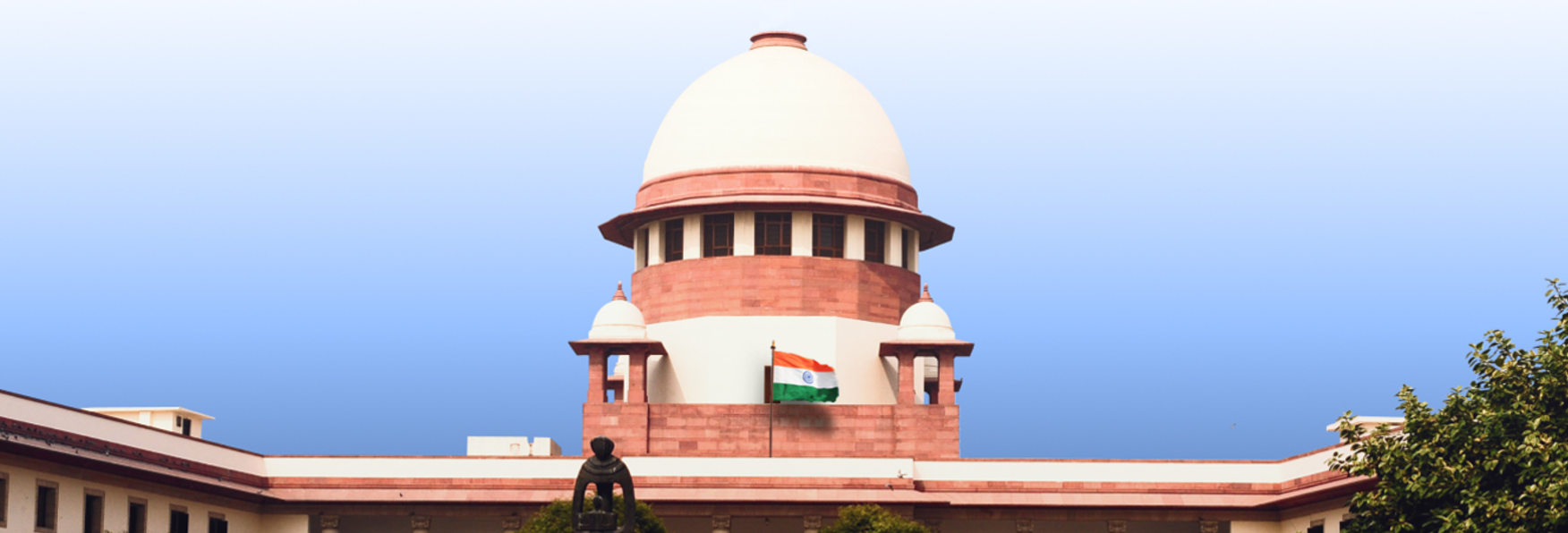
The Supreme Court of India stands as the highest judicial authority in the country, safeguarding the Constitution and ensuring justice for all citizens. At present, it is headed by the Chief Justice of India (CJI) and comprises 33 other judges appointed by the President of India.
Supreme Court is known as the guardian of the Constitution and has delivered numerous landmark judgments like the Kesavananda Bharati Case Judgment (1973) that have shaped Indian law and society. Keep reading to learn more about the Supreme Court of India.Supreme Court of India
The Supreme Court of India is the highest judicial authority in the integrated judicial system of the country. It was established in 1950 under the provisions of Article 124 of the Constitution of India. Below the Supreme Court of India, the judicial system is structured as follows:- High Courts: The highest courts at the state/union territory level, with original, appellate, and supervisory jurisdiction. There are 25 High Courts in India.
- District Courts: The primary courts at the district level, handling civil and criminal cases, and serving as appellate courts for lower courts.
- Subordinate Courts: These include Magistrate Courts and Sessions Courts. They are the first level of courts where cases are initially heard.
 Source:
Official Supreme Court
Source:
Official Supreme Court
History of Supreme Court of India
The Supreme Court of India was established on January 28, 1950 , under Article 124 of the Constitution. However, its evolution can be traced back to the colonial period:- Federal Court of India was established in 937 under the Government of India Act of 1935.
- Post-1947, the Federal Court continued to function until 1950.
- Later, the Supreme Court of India succeeded the Federal Court with the inauguration of the Constitution in 1950.
Composition of Supreme Court of India
The composition of the Supreme Court of India is determined by the parliament from time to time. Initially, the Supreme Court consisted of a Chief Justice and seven other judges. Over time, the number of judges has increased with the current composition to 34 (Chief Justice of India (CJI) and 33 judges ). The appointment process of judges to the Supreme Court is as follows:- Chief Justice of India (CJI): Appointed by the President of India.
- Other Judges : Appointed by the President after consultation with the Chief Justice and other senior judges.
- Supreme Court Registry: It is led by the Chief Justice with the Secretary General and manages court operations through two wings: Administration and Judicial.
- Attorney General: The Attorney General advises the government on legal matters, appears in all courts, and participates in Parliament but cannot vote.
-
Supreme Court Advocates:
- Senior Advocates : Designated by merit, can’t represent clients without an Advocate-on-Record.
- Advocates-on-Record: Only ones who can file documents in the Supreme Court.
- Other Advocates: Can argue cases but can't file documents.
- Amicus Curiae: Appointed to represent unrepresented parties or matters of public interest.
Qualifications of Judges of Supreme Court
To be appointed as a judge in the Supreme Court, a person must fulfill the following criteria:- Citizenship: The candidate must be a citizen of India.
-
Experience:
The individual must fulfill one of the following:
- Served as a judge of a High Court (or High Courts in succession) for at least five years.
- Practiced as an advocate in a High Court (or multiple High Courts) for at least ten years.
- Recognized as a distinguished jurist by the President of India.
Constitutional Provisions of Supreme Court
The Constitution of India explicitly outlines the establishment, jurisdiction, and other provisions related to the Supreme Court in Part V from Articles 124 to 147:| Constitutional Provisions of Supreme Court | |
| Article No. | Description |
| 124 | Establishment and Constitution of the Supreme Court |
| 124C | Authority of Parliament to enact laws regarding the Supreme Court |
| 125 | Determination of Judges' Salaries and Other Benefits |
| 126 | Appointment of an Acting Chief Justice |
| 127 | Appointment of Ad Hoc Judges to the Supreme Court |
| 128 | Role of Retired Judges in Attending Supreme Court Proceedings |
| 129 | The Supreme Court’s Status as a Court of Record |
| 130 | Official Seat of the Supreme Court |
| 131 | Original Jurisdiction of the Supreme Court |
| 132 to 134 | Appellate Jurisdiction from High Courts |
| 134A | Certification for Appeals to the Supreme Court |
| 135 | Continuation of Federal Court Jurisdiction by the Supreme Court under Existing Laws |
| 136 | Provision of Special Leave to Appeal to the Supreme Court |
| 137 | Review of Judgments and Orders of the Supreme Court |
| 138 | Expansion of the Supreme Court’s Jurisdiction |
| 139 | Empowerment of the Supreme Court to Issue Specific Writs |
| 139A | Transfer of Certain Cases to the Supreme Court |
| 140 | Ancillary Powers of the Supreme Court |
| 141 | Binding Nature of Laws Declared by the Supreme Court |
| 142 | Enforcement of Supreme Court Orders and Decrees, Including Discovery Matters |
| 143 | Power of the President to Consult the Supreme Court |
| 144 | Obligation of Civil and Judicial Authorities to Support the Supreme Court |
| 145 | Rules and Regulations Governing Supreme Court Procedures |
| 146 | Management of Officers, Staff, and Expenses of the Supreme Court |
Functions of Supreme Court of India
As the apex court, Supreme Court of India performs the following functions:- Interpret the Constitution: The Supreme Court is the ultimate authority on interpreting the Constitution of India, ensuring that its provisions are applied correctly in all matters of law.
- Review the Law: The court reviews the constitutionality of laws and executive actions. It can strike down any law or action that violates the Constitution.
- Guardian of Fundamental Rights : The Supreme Court plays a critical role in safeguarding the fundamental rights of citizens by issuing writs like habeas corpus, mandamus, and certiorari.
- Advising President: Under Article 143, the Supreme Court can offer advisory opinions to the President of India on legal matters of national importance.
- Dispute Resolution: The Supreme Court resolves disputes between states or between the Union and the states, especially in cases that fall under its original jurisdiction.
Powers of the Supreme Court of India
The powers and jurisdiction of the Supreme Court of India are outlined by the Constitution and are as follows:- Original Jurisdiction : The Supreme Court has exclusive original jurisdiction to resolve disputes between the Centre and states or among states as the first instance.
- Writ Jurisdiction: The Supreme Court can issue writs (habeas corpus, mandamus, prohibition, quo warranto, certiorari) for the enforcement of Fundamental Rights under Articles 32 and 226. This power is original but not exclusive, as High Courts also have this power.
- Appellate Jurisdiction : As India’s final court of appeal, the Supreme Court hears appeals in Constitutional, Civil, and Criminal matters along with the Special Leave Appeals.
- Advisory Jurisdiction: Under Article 143, the President can seek the Supreme Court's advisory opinion on questions of law or fact of public importance and disputes arising from pre-Constitution treaties or agreements.
- Court of Record: The Supreme Court’s judgments and proceedings are recorded to serve as legal precedents. It also has the power to punish for contempt of court.
- Power of Judicial Review : The Supreme Court can review laws and executive actions to ensure they comply with the Constitution.
- Other Powers: The Supreme Court has additional powers including resolving President and Vice-president election disputes, inquiring into UPSC members' conduct, reviewing its own judgments, transferring cases between High Courts, and exercising superintendence over all courts and tribunals.
| UPSC Related Articles | ||
| Gandhi Jayanti 2024 | International Solar Alliance | International Awards 2024 |
| Kumbh Mela 2025 | List of Statutory Bodies | Indus Waters Treaty |
Supreme Court of India FAQs
When was the Supreme Court established?
The Supreme Court of India was established on January 28, 1950.
What is the composition of the Supreme Court of India?
The Supreme Court consists of the Chief Justice of India and 33 other judges.
Which article is related to the Supreme Court?
Article 124 of the Constitution establishes the Supreme Court of India.
What is the qualification of a Supreme Court Judge?
A judge must be a citizen of India and have either 5 years of service as a High Court judge, 10 years of practice as an advocate in a High Court, or be a distinguished jurist.
What does Article 124 say?
Article 124 of the Constitution establishes the Supreme Court of India and defines its composition.
Talk to a counsellorHave doubts? Our support team will be happy to assist you!

Free Learning Resources
PW Books
Notes (Class 10-12)
PW Study Materials
Notes (Class 6-9)
Ncert Solutions
Govt Exams
Class 6th to 12th Online Courses
Govt Job Exams Courses
UPSC Coaching
Defence Exam Coaching
Gate Exam Coaching
Other Exams
Know about Physics Wallah
Physics Wallah is an Indian edtech platform that provides accessible & comprehensive learning experiences to students from Class 6th to postgraduate level. We also provide extensive NCERT solutions, sample paper, NEET, JEE Mains, BITSAT previous year papers & more such resources to students. Physics Wallah also caters to over 3.5 million registered students and over 78 lakh+ Youtube subscribers with 4.8 rating on its app.
We Stand Out because
We provide students with intensive courses with India’s qualified & experienced faculties & mentors. PW strives to make the learning experience comprehensive and accessible for students of all sections of society. We believe in empowering every single student who couldn't dream of a good career in engineering and medical field earlier.
Our Key Focus Areas
Physics Wallah's main focus is to make the learning experience as economical as possible for all students. With our affordable courses like Lakshya, Udaan and Arjuna and many others, we have been able to provide a platform for lakhs of aspirants. From providing Chemistry, Maths, Physics formula to giving e-books of eminent authors like RD Sharma, RS Aggarwal and Lakhmir Singh, PW focuses on every single student's need for preparation.
What Makes Us Different
Physics Wallah strives to develop a comprehensive pedagogical structure for students, where they get a state-of-the-art learning experience with study material and resources. Apart from catering students preparing for JEE Mains and NEET, PW also provides study material for each state board like Uttar Pradesh, Bihar, and others
Copyright © 2025 Physicswallah Limited All rights reserved.






